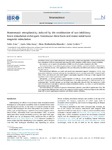Mostrar o rexistro simple do ítem
Homeostatic metaplasticity induced by the combination of two inhibitory brain stimulation techniques: continuous theta burst and transcranial static magnetic stimulation
| dc.contributor.author | Arias, Pablo | |
| dc.contributor.author | Adán-Arcay, Lucía | |
| dc.contributor.author | Madinabeitia-Mancebo, Elena | |
| dc.contributor.author | Cudeiro, Javier | |
| dc.date.accessioned | 2024-08-05T09:53:31Z | |
| dc.date.available | 2024-08-05T09:53:31Z | |
| dc.date.issued | 2024-07-15 | |
| dc.identifier.citation | Arias P, Adán-Arcay L, Madinabeitia-Mancebo E, Cudeiro J. Homeostatic metaplasticity induced by the combination of two inhibitory brain stimulation techniques: continuous theta burst and transcranial static magnetic stimulation. Neuroscience. 2024 Jul 15;554:128-136. | es_ES |
| dc.identifier.issn | 0306-4522 | |
| dc.identifier.uri | http://hdl.handle.net/2183/38389 | |
| dc.description.abstract | [Abstract] Aftereffects of non-invasive brain stimulation techniques may be brain state-dependent. Either continuous theta-burst stimulation (cTBS) as transcranial static magnetic field stimulation (tSMS) reduce cortical excitability. Our objective was to explore the aftereffects of tSMS on a M1 previously stimulated with cTBS. The interaction effect of two inhibitory protocols on cortical excitability was tested on healthy volunteers (n = 20), in two different sessions. A first application cTBS was followed by real-tSMS in one session, or sham-tSMS in the other session. When intracortical inhibition was tested with paired-pulse transcranial magnetic stimulation, LICI (ie., long intracortical inhibition) increased, although the unconditioned motor-evoked potential (MEP) remained stable. These effects were observed in the whole sample of participants regardless of the type of static magnetic field stimulation (real or sham) applied after cTBS. Subsequently, we defined a group of good-responders to cTBS (n = 9) on whom the unconditioned MEP amplitude reduced after cTBS and found that application of real-tSMS (subsequent to cTBS) increased the unconditioned MEP. This MEP increase was not found when sham-tSMS followed cTBS. The interaction of tSMS with cTBS seems not to take place at inhibitory cortical interneurons tested by LICI, since LICI was not differently affected after real and sham tSMS. Our results indicate the existence of a process of homeostatic plasticity when tSMS is applied after cTBS. This work suggests that tSMS aftereffects arise at the synaptic level and supports further investigation into tSMS as a useful tool to restore pathological conditions with altered cortical excitability. | es_ES |
| dc.language.iso | eng | es_ES |
| dc.publisher | Elsevier | es_ES |
| dc.relation.uri | https://doi.org/10.1016/j.neuroscience.2024.07.022 | es_ES |
| dc.rights | Creative Commons Attribution-NonCommercial-NoDerivs 4.0 International License (CC-BY-NC-ND 4.0) | es_ES |
| dc.rights.uri | http://creativecommons.org/licenses/by-nc-nd/3.0/es/ | * |
| dc.subject | Homeostatic plasticity | es_ES |
| dc.subject | Human | es_ES |
| dc.subject | Non-invasive brain stimulation | es_ES |
| dc.subject | Theta-burst stimulation | es_ES |
| dc.subject | Transcranial magnetic stimulation | es_ES |
| dc.subject | Transcranial static magnetic field | es_ES |
| dc.title | Homeostatic metaplasticity induced by the combination of two inhibitory brain stimulation techniques: continuous theta burst and transcranial static magnetic stimulation | es_ES |
| dc.type | info:eu-repo/semantics/article | es_ES |
| dc.rights.access | info:eu-repo/semantics/openAccess | es_ES |
| UDC.journalTitle | Neuroscience | es_ES |
| UDC.volume | 554 | es_ES |
| UDC.startPage | 128 | es_ES |
| UDC.endPage | 136 | es_ES |
| dc.identifier.doi | 10.1016/j.neuroscience.2024.07.022 |
Ficheiros no ítem
Este ítem aparece na(s) seguinte(s) colección(s)
-
GI-NEURO - Artigos [164]






